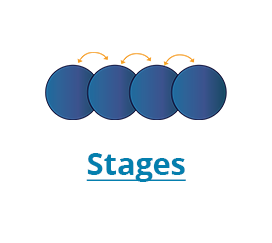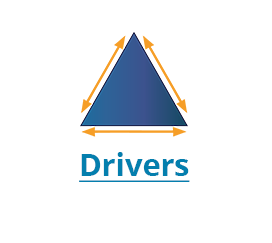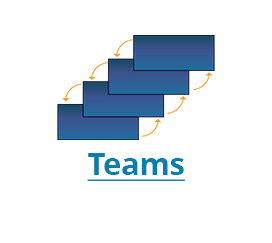Start Here
Active Implementation Learner Pathways
Learning pathways in implementation science serve as structured routes for individuals to effectively acquire the necessary knowledge, skills, and competencies to translate evidence-based interventions into real-world settings.
Handout: Usable Innovations One-Pager
A Usable Innovation needs to be teachable, learnable, doable, and readily assessed in practice if it is to be used effectively to reach all students who could benefit.
Tool: Initiative Inventory
These tools can be used to plan and guide your team's review of past and current programs to get a clear picture of successful strategies and challenges, along with existing mandates and resource commitments.
Tool: The Hexagon – An Exploration Process
The Hexagon Tool can be used by communities and organizations to better understand how a new or existing program or practice fits into an implementing site's current work and context.
Usable Innovations Overview (Module 6)
Formally known as “modules” on the AI Hub, we have condensed the information into document overviews. As you begin your journey, take a moment to read about Usable Innovations.
Dive Deeper: Read
Accomplishing Effective and Durable Change to Support Improved Student Outcomes
This white paper, released by SISEP and the Kentucky Department of Education, shares Kentucky's journey and learnings from using implementation science to improve student outcomes.
Brief: Development of the Michigan Department of Education Multi-Tiered System of Supports Practice Profile
This Brief highlights how the Michigan Department of Education (MDE) engaged systematically and purposefully in the practice profile development process to clearly define Multi-Tiered System of Supports (MTSS).
Co-creation of Kentuckys Usable Innovation: A How-To-Guide
This publication serves as a technical paper or How-To-Guide through a detailed description of the intentional step-by-step process Kentucky's executive leaders, educators, and stakeholders used to co-create a Mathematics Usable Innovation.
Guidance for Engaging Critical Perspectives
Guidance for Engaging Critical Perspectives
Handout: Practice Profile Examples
Practice profiles enable a program to be teachable, learnable, and doable in typical human service settings. You will find multiple examples of practice profiles to further your understanding of their content. Examples are included from the Michigan Department of Education, the Colorado Department of Education, the Wisconsin Department of Education, the Kentucky Department of Education, and the Florida Department of Education.
Handout: Usable Innovations One-Pager
A Usable Innovation needs to be teachable, learnable, doable, and readily assessed in practice if it is to be used effectively to reach all students who could benefit.
Hexagon Tool Case Studies
A series of case studies to study and share findings on enabling conditions for successful math instructional materials implementation.
Hexagon Tool Process – Lessons Learned
The Hexagon Tool was the number one resource accessed in 2021 on the Active Implementation Hub. What is so fascinating about this tool? Why is this resource the most utilized out of all of the resources on the AI Hub?
Program Developer Interview Guide
This guide provides questions to ask of a program developer to determine what supports are necessary to implement, continuously improve, and sustain their program.
Scaling-Up Brief 1: Scaling Up Evidence-Based Practices in Education
The purpose of this Brief is to provide a framework that state leadership teams and others can use to develop the capacity to make effective, statewide, and sustained use of evidence-based practices and other innovations.
So, we did the Hexagon Tool. Now What?
The data collected during the process of using the Hexagon Tool can take us further than the initial decision to implement, de-implement, or refine a practice (Metz & Louison, 2018). Those data can be the starting place for audacious planning and systemic changes.
Usable Innovations Overview (Module 6)
Formally known as “modules” on the AI Hub, we have condensed the information into document overviews. As you begin your journey, take a moment to read about Usable Innovations.
What is Fidelity?
Fidelity is a complex concept and utilizing fidelity measurements and data at all levels of the teaming cascade is needed to support staff with implementation. This brief provides a deep dive into this concept, with real-world examples.
White Paper: Practice Profiles – A Process for Capturing Evidence and Operationalizing Innovations
The purpose of this piece is to provide the research and rationales behind Practice Profiles. To achieve outcomes and develop effective implementation supports, innovations need to be “teachable, learnable, doable, and assessable.”
Dive Deeper: Watch
Lesson: Initiative Inventory
This brief lesson supports your learning about how to collect and analyze data for the Initiative Inventory and use the results to inform selection, de-selection, and alignment decisions for practices or programs.
Lesson: Practice Profiles
Practice profiles enable a program to be teachable, learnable, and doable in typical human service settings.
Lesson: Usable Innovations
After this lesson you will be able to identify criteria that distinguish a usable innovation as well as select and employ appropriate tools and processes for assessing the fit of an innovation.
Voices from the Field Video Series (Evidence-Based Practices)
Voices from the Field Video Series: Evidence-based Practices
Dive Deeper: Listen
Dive Deeper: Reflect
Activity: Evidence-based Practice Drive Around
Jot down different EBPs/EIIs that you have experienced, participated in, or led, and pick one of those initiatives that have been in place the longest. Then, drive around the Implementation Drivers diagram and reflect on the questions provided.
Activity: Exploring with the Hexagon Tool
The Hexagon Tool is designed to help states, districts, and schools systematically evaluate new and existing innovations via six broad factors: needs, fit, resource availability, evidence, readiness for replication and capacity to implement.
Activity: Exploring with the Initiative Inventory
Before starting something new, reviewing what already exists and how your district uses existing resources is important. This activity can help delineate how much is already being asked of staff and determine if the new will fit the existing.
Activity: Is my Practice or Program Usable?
In order for a program or practice to be usable, it must be defined with sufficient detail to be implemented with fidelity, measured in use, and replicated across multiple settings.
Activity: Reflecting on Rationales
Think about a time you were trying to use a new education skill or program. As an individual or with your team, reflect on these questions.
Activity: Usable Innovations and PDSA Case Example
This case provides an example of an approach to establishing Usable Innovations. Review the case example, then go through the discussion questions yourself, or with your team.
Apply
Lesson: The Hexagon Tool
The Hexagon Tool can be used by communities and organizations to better understand how a new or existing program or practice fits into an implementing site existing work and context. View the interactive lesson and download companion resources.
PBIS School-wide Evaluation Tool
In this example of a fidelity assessment, items are designed to detect the presence and strength of each PBIS core feature in a school environment. Data source may be a product, interview, or observation. These ways of assessing fidelity are summarized in the handout.
Tool: Initiative Inventory
These tools can be used to plan and guide your team's review of past and current programs to get a clear picture of successful strategies and challenges, along with existing mandates and resource commitments.
Tool: Practice Profile Planning Template
This planning tool will help you identify the core components (essential functions) of your evidence based program, as well as expected, developmental and unacceptable practice variations.
Tool: The Hexagon – An Exploration Process
The Hexagon Tool can be used by communities and organizations to better understand how a new or existing program or practice fits into an implementing site's current work and context.






